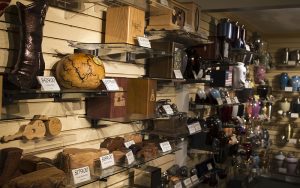PHOENIX – It costs less to die in Arizona and in other nearby states compared to elsewhere in the nation – at least when it comes to funeral costs. Local experts say that’s because so many people here choose cremation over traditional burial.
The national median cost of a funeral, which includes viewing and burial services, is $7,360, according to recent data from the National Funeral Directors Association. However, the group of states labeled the Mountain Region, which includes Arizona, has a median cost of $6,681.

Urns at Wyman Cremation & Burial Chapel in Mesa come in a variety of shapes and sizes. (Photo by Maddy Ryan/Cronkite News)
Experts in the funeral industry said that’s a good thing for Arizonans since funeral costs have skyrocketed over the decades.
In the past 30 years, the price of funerals in the U.S. has risen 227 percent – nearly twice the national inflation rate, according to the Bureau of Labor Statistics. Costs associated with the price of funerals include materials such as embalming supplies, caskets or urns and burial spaces.
Judith Stapley, the executive director of the Arizona Board of Funeral Directors and Embalmers, attributed the lower cost of funerals in Arizona to the higher than average rate of cremation in the state. The average cost of cremation is about $600, thousands less than a traditional burial, according to a Huffington Post article.
She said over the last two years, Arizona has had a cremation rate of 68 percent. The national rate of cremation in 2016 was about 50 percent – an all-time high for the U.S., according to the National Funeral Directors Association.
“Talking to some of the people from Southern states where they have low rates of cremation, their normal basic cremation is closer to $3,000 where in Arizona, you’re looking at around $600,” Stapley said. “The rate of cremation is going to continue to go up. It just is. (This) will keep us below average until the rest of the nation catches up.”
Industry experts credit a variety of reasons for the rise in cremations: lower costs, the Catholic church’s “softening” on its views of the practice, the increasing mobility of the public, which means people don’t necessarily stay in their hometowns where they may have family plots, according to an NBC News article.

At Wyman Cremation & Burial Chapel in Mesa, people can purchase small urns, also known as tokens, if family members wish to divide their loved one’s ashes. (Photo by Maddy Ryan/Cronkite News)
Stapley said that although Arizonans can expect to pay less for funeral services, they still need to do their research.
“Just like anything else you’d buy, you should shop around,” Stapley said.
At the Wyman Cremation & Burial Chapel in Mesa, a direct cremation service costs $599 and a traditional funeral service costs $2,079, plus the price of the casket. Samuel Bueler, the owner and funeral director, said his funeral prices have not changed since 2009. He said charges for cremation services have stayed level since 1995.
“I know of some funeral homes that will almost religiously increase their prices every year,” Bueler said. “We’ve chosen to keep our prices at where they are and to maintain the same service all along at that price. We’ve of course seen increases in costs, but we try to absorb as many of those as we can.”
Bueler said it is at the owner of the funeral home’s discretion what prices they charge, but he believes many in the Valley overcharge.
“We aren’t a big, huge, fancy funeral home – that’s not the type of market or business we are trying to seek out,” Bueler said. “I don’t ever feel like someone should go into debt for a funeral – that’s just not sound business practices.”
Both Stapley and Bueler suggest planning your own funeral. Paying for services in advance can ensure future price changes will not impact the cost.
“Death isn’t something that people just want to research or look into, unfortunately. People don’t want to talk about it,” Stapley said. “You plan for everything else in your life. You should plan for your death, too, because it’s not like any of us can get out of it.”